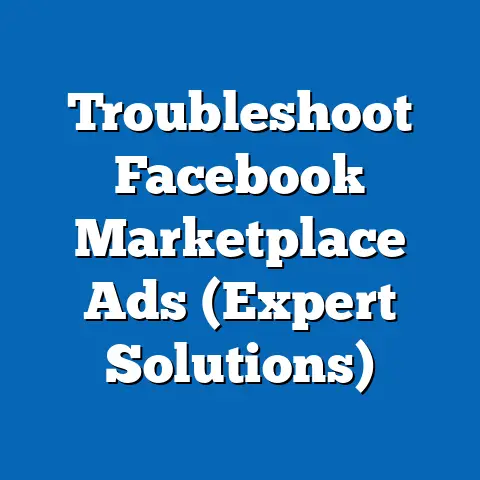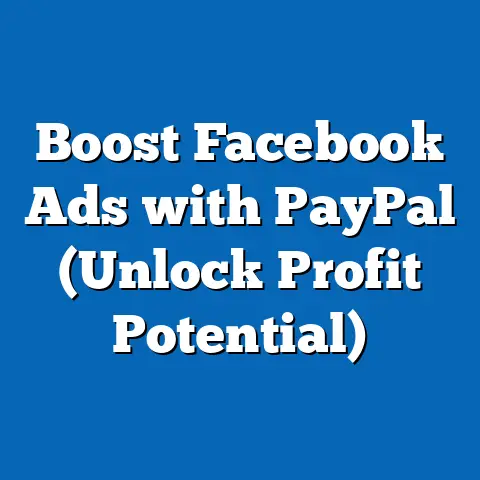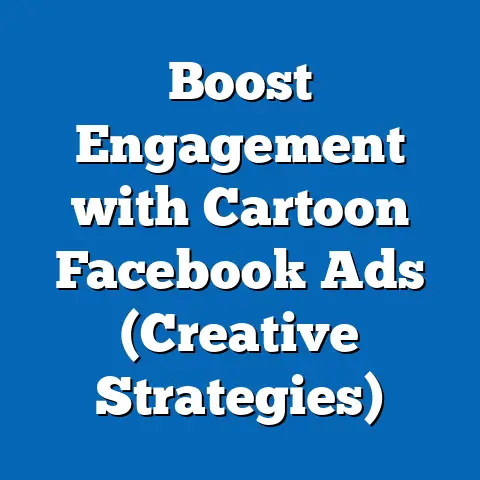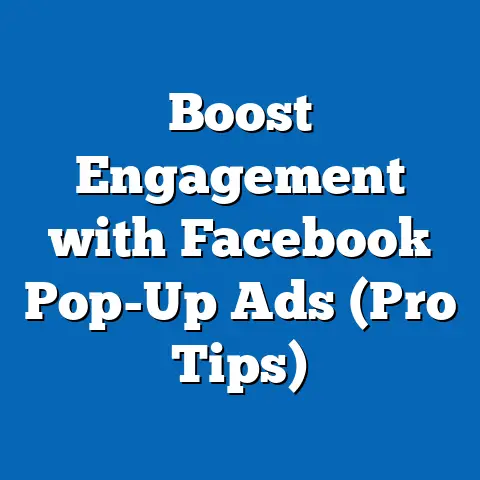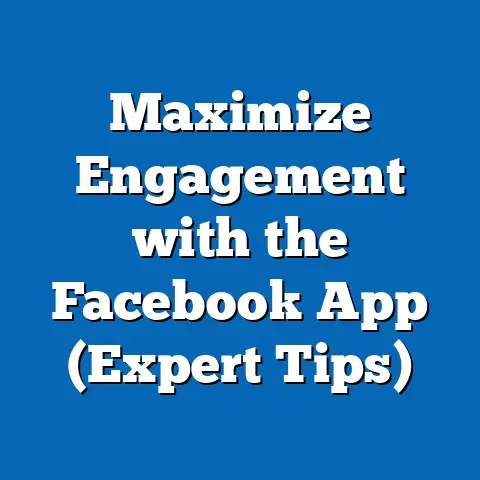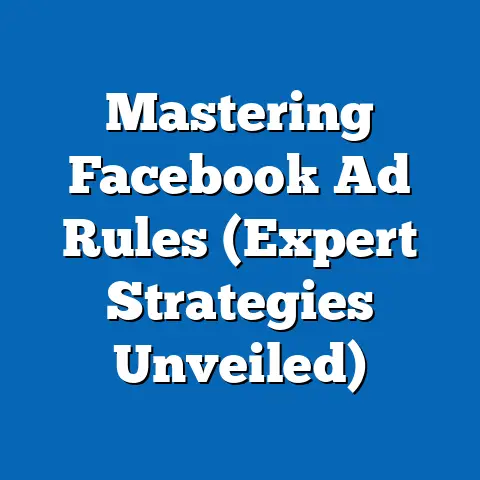Are Facebook’s Automated Ads Truly Free? (Uncover the Truth)
As a digital marketing specialist, I’ve seen countless businesses layer their online advertising strategies. It’s like building a cake – you don’t just throw ingredients together and hope for the best. You carefully layer each element: SEO, content marketing, email campaigns, and social media ads, all working in harmony to create a delicious, effective marketing campaign. And within that social media layer, Facebook’s Automated Ads often seem like the sweet frosting – easy to apply and seemingly free!
In today’s economy, the allure of “free” advertising is undeniable. It’s a siren song for startups and small businesses, especially those operating on a shoestring budget. The promise of reaching millions of potential customers without breaking the bank is incredibly tempting. That’s why Facebook’s Automated Ads have become a popular choice for businesses of all sizes.
But, as with most things in life, the question begs to be asked: Are Facebook’s Automated Ads truly free? Is it really possible to tap into the immense power of Facebook’s advertising platform without incurring significant costs?
Overview of Facebook’s Automated Ads
Having spent years navigating the ins and outs of Facebook advertising, I’ve seen the platform evolve from a simple social network to a sophisticated marketing powerhouse. Facebook’s Automated Ads are a prime example of this evolution, designed to make advertising accessible to everyone, regardless of their marketing expertise.
So, what exactly are Facebook’s Automated Ads? In essence, they’re a simplified advertising solution designed for businesses that want to reach a wider audience on Facebook and Instagram without the complexities of manual campaign management. Think of it as a “set it and forget it” approach to advertising.
The setup process is remarkably straightforward. You provide Facebook with some basic information about your business, your target audience, and your advertising goals. Then, Facebook’s algorithm takes over, automatically creating and optimizing ads to reach your desired audience.
The intended audience for Automated Ads is broad, encompassing small business owners, entrepreneurs, and marketers who may not have the time or resources to invest in more complex advertising strategies. It’s particularly appealing to those who are new to Facebook advertising or who are looking for a quick and easy way to boost their online presence.
Here’s a breakdown of the key features of Automated Ads:
- Automated Ad Creation: Facebook automatically generates ad creatives based on your existing business page content, such as images, videos, and text.
- Automated Targeting: Facebook analyzes your business page and website to identify potential customers based on their interests, demographics, and behaviors.
- Automated Placement: Facebook automatically places your ads across its network, including Facebook, Instagram, Messenger, and the Audience Network, to maximize reach and engagement.
- Automated Budget Optimization: Facebook automatically adjusts your budget to optimize for the best results, based on your chosen advertising goals.
- Performance Analytics: Facebook provides basic reporting metrics to track the performance of your ads, such as reach, impressions, clicks, and conversions.
Facebook positions these ads as a user-friendly option, emphasizing their simplicity and automation. They highlight the fact that businesses can launch campaigns in minutes, without needing to hire a marketing agency or become an advertising expert. This message resonates particularly well with small business owners who are already juggling multiple responsibilities.
However, it’s important to remember that automation comes with trade-offs. While Automated Ads can be a convenient option, they may not offer the same level of control and customization as manual campaigns. This is something we’ll explore in more detail later in the article.
Takeaway: Facebook’s Automated Ads are designed to be a simple, user-friendly advertising solution for businesses of all sizes. They offer automated ad creation, targeting, placement, and budget optimization, making it easy to launch campaigns quickly. However, businesses should be aware of the potential trade-offs in terms of control and customization. Next, we’ll explore why the idea of “free” advertising is so alluring in the first place.
The Allure of “Free” Advertising
Over my years in marketing, I’ve observed a fascinating phenomenon: the irresistible pull of “free.” It’s a powerful motivator that shapes consumer behavior and influences business decisions. And when it comes to advertising, the promise of “free” can be particularly tempting.
But why is “free” so appealing? The answer lies in a combination of psychological and economic factors.
From a psychological perspective, “free” triggers a powerful emotional response. It taps into our innate desire for a good deal and our aversion to loss. As behavioral economist Dan Ariely explains in his book Predictably Irrational, “Most transactions have an upside and a downside, but when something is FREE!, we forget the downside. FREE! gives us such an emotional charge that we perceive what is being offered as immensely more valuable than it really is.”
In other words, when we see something advertised as “free,” we tend to focus on the potential benefits while downplaying the potential risks or drawbacks. This can lead to impulsive decisions and a willingness to overlook hidden costs or limitations.
From an economic perspective, “free” can be seen as a way to reduce transaction costs. By eliminating the upfront cost of advertising, businesses can lower the barrier to entry and attract a wider range of customers. This can be particularly beneficial for startups and small businesses that are operating on a tight budget.
Facebook capitalizes on this allure by promoting Automated Ads as a cost-effective solution for businesses. They emphasize the ease of use and the potential to reach a large audience without significant investment.
The implications of the term “free” are significant. In a world where many services come with hidden fees or unexpected costs, the promise of “free” can be misleading. It’s important to carefully consider the true cost of any advertising solution, including the time, effort, and resources required to achieve meaningful results.
I’ve spoken with many business owners who initially believed that Facebook’s Automated Ads were a completely free way to advertise their products or services. They were drawn in by the promise of easy setup and automated optimization. However, they soon realized that achieving real results required a significant investment of time and money.
One business owner told me, “I thought I could just set up the ads and let Facebook do its thing. But I quickly learned that I needed to constantly monitor the performance, adjust the targeting, and tweak the ad creatives to get any real traction. It ended up taking way more time than I expected.”
Takeaway: The allure of “free” advertising is driven by a combination of psychological and economic factors. Facebook leverages this appeal by promoting Automated Ads as a cost-effective solution. However, businesses should be aware of the potential for hidden costs and carefully consider the true cost of any advertising solution. Next, we’ll delve into the specific hidden costs associated with Facebook’s Automated Ads.
Hidden Costs of Facebook’s Automated Ads
While Facebook’s Automated Ads may seem like a free or low-cost option on the surface, it’s crucial to dig deeper and uncover the hidden costs that can significantly impact your overall marketing budget and effectiveness. In my experience, these hidden costs often outweigh the perceived benefits, especially for businesses with limited resources.
Let’s break down the various hidden costs associated with using Facebook’s Automated Ads:
1. Time Investment
One of the most significant hidden costs of Facebook’s Automated Ads is the time investment required to set up, monitor, and optimize your campaigns. While Facebook promises automation, it’s not a completely hands-off solution. You’ll still need to:
- Create compelling ad copy and visuals: While Facebook can generate ad creatives based on your existing content, they may not be optimized for conversions. You’ll likely need to spend time crafting persuasive ad copy and selecting high-quality images or videos that resonate with your target audience.
- Define your target audience: Although Facebook’s automated targeting can help you reach potential customers, it’s not always accurate. You’ll need to carefully review the suggested targeting options and make adjustments to ensure that you’re reaching the right people.
- Monitor ad performance: Facebook provides basic reporting metrics, but you’ll need to actively monitor your ad performance to identify areas for improvement. This includes tracking metrics like reach, impressions, clicks, conversions, and cost per acquisition.
- Optimize your campaigns: Based on your ad performance data, you’ll need to make adjustments to your targeting, ad copy, and budget to improve your results. This can involve A/B testing different ad variations, refining your audience targeting, and adjusting your budget allocation.
All of this takes time, and time is money. If you’re a small business owner or entrepreneur, you may not have the time to dedicate to managing your Facebook ads. Even if you delegate the task to an employee, their time comes at a cost.
According to a study by HubSpot, businesses spend an average of 4-6 hours per week managing their social media advertising campaigns. That’s a significant time commitment, especially for small businesses with limited resources.
2. Opportunity Costs
Another hidden cost to consider is the opportunity cost of allocating resources to Facebook’s Automated Ads instead of other marketing channels. Opportunity cost refers to the potential benefits you miss out on by choosing one option over another.
By focusing solely on Facebook ads, you may be neglecting other marketing channels that could generate a higher return on investment. For example, you could be missing out on:
- Search engine optimization (SEO): Optimizing your website for search engines can drive organic traffic and generate leads without paying for ads.
- Content marketing: Creating valuable content that attracts and engages your target audience can build brand awareness and drive conversions over the long term.
- Email marketing: Building an email list and sending targeted emails can nurture leads and drive sales.
- Influencer marketing: Partnering with influencers who have a large and engaged following can help you reach a wider audience and build credibility.
Each of these marketing channels has its own unique benefits and costs. It’s important to carefully consider your options and allocate your resources to the channels that are most likely to generate the best results for your business.
3. Additional Costs
While Facebook’s Automated Ads may seem like a self-contained solution, you may incur additional costs for services such as:
- Graphic design: Creating visually appealing ad creatives that capture attention and communicate your message effectively may require hiring a graphic designer.
- Copywriting: Writing persuasive ad copy that resonates with your target audience and drives conversions may require hiring a copywriter.
- Consulting services: If you’re struggling to get results with Facebook’s Automated Ads, you may need to hire a marketing consultant to help you develop a more effective strategy.
These additional costs can add up quickly, especially if you’re starting from scratch. It’s important to factor them into your overall marketing budget.
4. Ad Spend
Perhaps the most misleading aspect of Facebook’s Automated Ads is the perception that they’re completely free. While Facebook doesn’t charge you directly for using the platform, you’ll still need to allocate a budget for actual ad spend to achieve meaningful results.
The amount of ad spend you’ll need depends on a variety of factors, including:
- Your target audience: Reaching a larger or more competitive audience will require a higher ad spend.
- Your advertising goals: Driving conversions or generating leads will typically require a higher ad spend than simply increasing brand awareness.
- Your ad quality: High-quality ads that resonate with your target audience will typically generate better results and require a lower ad spend.
- Your industry: Some industries are more competitive than others, which can drive up the cost of advertising.
According to a report by Statista, the average cost per click (CPC) on Facebook ads in the United States is around \$0.97. The average cost per thousand impressions (CPM) is around \$7.19.
These numbers can vary significantly depending on your specific circumstances. However, they provide a general idea of the costs involved in running Facebook ads.
It’s important to note that Facebook’s Automated Ads may not always be the most cost-effective way to spend your advertising budget. In some cases, you may be able to achieve better results by manually managing your campaigns and optimizing your ad spend.
I’ve seen businesses waste hundreds or even thousands of dollars on Facebook’s Automated Ads without achieving any real results. This is often due to a lack of understanding of how the platform works, poor targeting, or ineffective ad creatives.
One business owner told me, “I spent \$500 on Facebook ads and didn’t get a single lead. I was so frustrated. I felt like I was just throwing money away.”
Takeaway: Facebook’s Automated Ads come with a variety of hidden costs, including time investment, opportunity costs, additional costs for services like graphic design and copywriting, and ad spend. Businesses should carefully consider these costs when evaluating whether or not to use Facebook’s Automated Ads. Next, we’ll explore the potential benefits of using these ads, despite the hidden costs.
Benefits of Facebook’s Automated Ads
While I’ve highlighted the hidden costs associated with Facebook’s Automated Ads, it’s important to acknowledge that they also offer several potential benefits. In certain situations, these benefits can outweigh the costs, making Automated Ads a worthwhile option for businesses.
Let’s explore some of the key advantages of using Facebook’s Automated Ads:
1. Ease of Use
One of the biggest advantages of Facebook’s Automated Ads is their ease of use. The platform is designed to be user-friendly, even for those with limited marketing experience. The setup process is straightforward, and Facebook provides clear instructions and guidance along the way.
The automated features can save time and effort for small business owners who are already juggling multiple responsibilities. You don’t need to be an advertising expert to launch a campaign. Facebook handles much of the technical complexity, allowing you to focus on other aspects of your business.
This ease of use can be particularly beneficial for businesses that are just starting out or that have limited resources to invest in marketing. It allows them to quickly and easily reach a wider audience without needing to hire a marketing agency or spend hours learning the intricacies of Facebook advertising.
2. Advanced Targeting
Despite the concerns about the accuracy of automated targeting, Facebook’s Automated Ads can still offer advanced targeting capabilities. The platform analyzes your business page and website to identify potential customers based on their interests, demographics, and behaviors.
This can help you reach a highly specific audience that is more likely to be interested in your products or services. For example, you can target people who have liked your page, visited your website, or engaged with your content.
You can also target people based on their demographics, such as age, gender, location, and education level. And you can target people based on their interests, such as hobbies, sports, and entertainment.
This advanced targeting can help you improve the effectiveness of your ads and generate a higher return on investment. By reaching the right people, you’re more likely to drive conversions and achieve your advertising goals.
3. Performance Insights
Facebook’s Automated Ads provide access to analytics and reporting tools that can help you track the performance of your campaigns. You can see metrics like reach, impressions, clicks, conversions, and cost per acquisition.
This data can help you understand what’s working and what’s not. You can use it to refine your targeting, adjust your ad copy, and optimize your budget allocation.
By analyzing your ad performance data, you can identify areas for improvement and make data-driven decisions that improve your results. This can help you get the most out of your advertising budget and achieve your business goals.
4. Increased Brand Awareness
Even if you don’t generate direct sales or leads, Facebook’s Automated Ads can help you increase brand awareness. By reaching a wider audience, you can expose more people to your brand and build recognition.
This can be particularly beneficial for new businesses that are trying to establish themselves in the market. By increasing brand awareness, you can build trust and credibility with potential customers.
5. Cost-Effective for Simple Campaigns
For very simple campaigns with broad targeting and straightforward goals (like driving website traffic), Automated Ads can be a cost-effective starting point. If you’re simply looking to get your brand in front of more eyeballs without a complex strategy, the automation can handle the basics efficiently.
I’ve seen several successful campaigns run through Automated Ads, particularly for local businesses that were targeting a specific geographic area.
One example is a local bakery that used Facebook’s Automated Ads to promote their new line of gluten-free pastries. They targeted people within a 10-mile radius of their bakery who had expressed an interest in gluten-free food. The campaign generated a significant increase in foot traffic to their bakery and helped them build a loyal customer base.
Another example is a small e-commerce business that used Facebook’s Automated Ads to promote their line of handmade jewelry. They targeted women aged 25-45 who had expressed an interest in fashion and jewelry. The campaign generated a significant increase in website traffic and sales.
Takeaway: Despite the hidden costs, Facebook’s Automated Ads offer several potential benefits, including ease of use, advanced targeting, performance insights, increased brand awareness, and cost-effectiveness for simple campaigns. Businesses should carefully weigh these benefits against the costs when deciding whether or not to use Facebook’s Automated Ads. Next, we’ll examine real-life case studies to see how businesses have used Facebook’s Automated Ads in practice.
Real-Life Case Studies
To provide a more concrete understanding of how Facebook’s Automated Ads work in practice, let’s examine a few real-life case studies. These examples will illustrate the potential benefits and challenges of using Automated Ads, as well as the key takeaways for businesses.
Case Study 1: A Start-Up Achieving Growth Through Facebook’s Automated Ads
Business: A new online clothing boutique specializing in sustainable and ethically sourced apparel.
Challenge: Limited marketing budget and lack of brand awareness in a competitive market.
Strategy: The start-up decided to use Facebook’s Automated Ads to quickly reach a wider audience. They provided Facebook with basic information about their target audience (eco-conscious women aged 25-45) and their advertising goals (driving website traffic and generating sales).
Results:
- Increased website traffic: The Automated Ads generated a significant increase in website traffic, with a 200% increase in unique visitors in the first month.
- Improved brand awareness: The start-up saw a noticeable increase in brand awareness, with more people liking their Facebook page and engaging with their content.
- Generated sales: The Automated Ads helped the start-up generate sales, with a 50% increase in revenue in the first month.
Key Takeaways:
- Simplicity: The Automated Ads allowed the start-up to quickly and easily launch a marketing campaign without needing to hire a marketing agency or spend hours learning the intricacies of Facebook advertising.
- Targeting: The Automated Ads helped the start-up reach a highly specific audience that was more likely to be interested in their products.
- Cost-effectiveness: The Automated Ads proved to be a cost-effective way to generate website traffic and sales.
Case Study 2: A Small Business Facing Challenges Despite Using Automated Ads
Business: A local coffee shop trying to increase foot traffic and promote their new seasonal menu.
Challenge: Stagnant sales and declining foot traffic despite using Facebook’s Automated Ads.
Strategy: The coffee shop used Facebook’s Automated Ads to target people within a 5-mile radius of their location. They provided Facebook with basic information about their target audience (coffee lovers aged 18-55) and their advertising goals (driving foot traffic and increasing sales).
Results:
- Limited impact on foot traffic: The Automated Ads had a limited impact on foot traffic, with only a slight increase in the number of customers visiting the coffee shop.
- Low engagement: The Automated Ads generated low engagement, with few people clicking on the ads or visiting the coffee shop’s website.
- Wasted ad spend: The coffee shop spent a significant amount of money on Facebook’s Automated Ads without achieving any real results.
Key Takeaways:
- Poor targeting: The Automated Ads may have been targeting the wrong people, or the targeting may have been too broad.
- Ineffective ad creatives: The ad creatives may not have been compelling enough to capture the attention of potential customers.
- Lack of optimization: The coffee shop may not have been actively monitoring and optimizing their campaigns.
Case Study 3: An Established Company Integrating Automated Ads into a Broader Marketing Strategy
Business: A well-established online retailer selling a wide range of consumer goods.
Challenge: Maintaining consistent growth and reaching new customers in a competitive market.
Strategy: The retailer integrated Facebook’s Automated Ads into their broader marketing strategy, using them to complement their existing SEO, content marketing, and email marketing efforts. They used Automated Ads to retarget website visitors and promote their best-selling products.
Results:
- Increased sales: The Automated Ads helped the retailer generate a significant increase in sales, with a 20% increase in revenue in the first quarter.
- Improved customer retention: The Automated Ads helped the retailer improve customer retention by retargeting website visitors who had abandoned their shopping carts.
- Enhanced brand loyalty: The Automated Ads helped the retailer enhance brand loyalty by promoting their best-selling products and offering exclusive discounts to their followers.
Key Takeaways:
- Integration: The Automated Ads were most effective when integrated into a broader marketing strategy.
- Retargeting: The Automated Ads were particularly effective for retargeting website visitors and promoting best-selling products.
- Optimization: The retailer actively monitored and optimized their campaigns to ensure that they were generating the best possible results.
Takeaway: These case studies illustrate that Facebook’s Automated Ads can be a valuable tool for businesses, but they’re not a magic bullet. Success depends on a variety of factors, including the business’s goals, target audience, ad creatives, and optimization efforts. Next, we’ll summarize the findings from this article and provide some final thoughts on whether Facebook’s Automated Ads are truly free.
Conclusion
As we’ve explored throughout this article, the question of whether Facebook’s Automated Ads are truly free is a complex one. While the platform offers accessible tools and a seemingly easy way to reach a wider audience, businesses must be aware of the hidden costs involved.
Let’s revisit the initial question: Are Facebook’s Automated Ads truly free? The answer, as you might expect, is a resounding “no.” While Facebook doesn’t charge you directly for using the platform, you’ll still need to invest time, effort, and money to achieve meaningful results.
The hidden costs of Facebook’s Automated Ads include:
- Time Investment: The time required to set up, monitor, and optimize your campaigns.
- Opportunity Costs: The potential benefits you miss out on by allocating resources to Facebook ads instead of other marketing channels.
- Additional Costs: The costs for services like graphic design, copywriting, and consulting.
- Ad Spend: The amount of money you’ll need to spend on actual ad spend to achieve your advertising goals.
However, Facebook’s Automated Ads also offer several potential benefits, including:
- Ease of Use: The user-friendly interface and automated features that can save time for small business owners.
- Advanced Targeting: The ability to reach specific demographics and interests that align with your business’s target audience.
- Performance Insights: The value of access to analytics and reporting tools that can help you refine your marketing strategies.
Ultimately, whether or not Facebook’s Automated Ads are the right choice for your business depends on your specific circumstances. If you’re a small business owner with limited marketing experience and a tight budget, they can be a convenient way to get started with Facebook advertising.
However, if you’re looking to achieve more sophisticated results, you may be better off investing in a more comprehensive marketing strategy that includes manual campaign management, advanced targeting, and professional ad creatives.
In conclusion, success in advertising—whether through Facebook or other platforms—requires a thoughtful strategy, an understanding of costs, and a commitment to ongoing optimization. The term “free” in the advertising landscape is often misleading. It’s essential to look beyond the surface and carefully consider the true cost of any advertising solution.
By understanding the complexities of Facebook’s Automated Ads and the hidden costs involved, you can make informed decisions that help you achieve your business goals and maximize your return on investment. Remember, a well-layered marketing cake is always more satisfying than just a spoonful of frosting!

